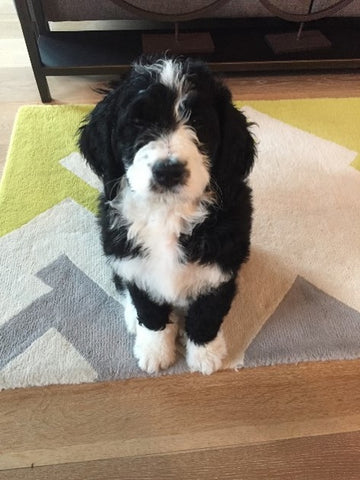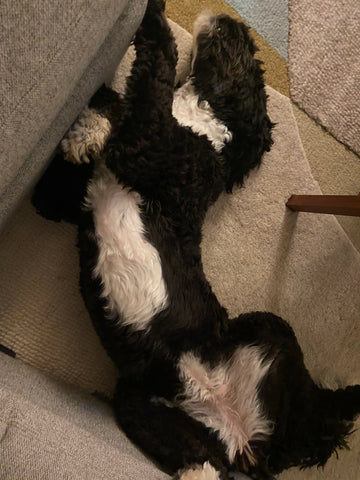How our Bernedoodles got us thinking that every dog could benefit from a chew stick holder
The Chew Works Hold-a-Chew chew stick holder was invented after our four-month-old Bernedoodle, Lucy, swallowed an 8-inch bully stick. One minute she was this cute little fluff ball, happily chewing away. The next she was sitting there looking at my husband and me, very confused about where her chew stick went. It obviously didn’t faze her too much, but it sent us into a bit of a panic. We did a lot of Googling, trying to determine whether a trip to the emergency vet was needed. In the end, we were lucky that she was able to digest it. We breathed a sigh of relief and decided we probably shouldn’t give Lucy chew sticks. Well, based on where we’re at now, that didn’t last 😊. Lucy needed to chew!
 Lucy at 4 months. Yes, she was big (30 lbs.!) but there’s no dog of any size that should swallow an 8-inch bully stick!
Lucy at 4 months. Yes, she was big (30 lbs.!) but there’s no dog of any size that should swallow an 8-inch bully stick!
But the reality is that most dogs need to chew. It’s inherent in their behavior and it is possible to give them this outlet safely, while at the same time training them to chew the right thing.
A chew stick holder is a safer way to give your pup a long-lasting chew but there might be more to gain.
A chew stick holder will help keep aggressive chewers safe from choking and swallowing large chew stick pieces, but there are reasons why all dogs – and their parents – can benefit from a chew stick holder:
1. To channel energy and boredom.
Dogs need stimulation and a way to channel their energy – and sometimes their anxiety. While our first Bernedoodle, Lucy, was a natural chewer, her younger sister Daisy was not. She was even more energetic than Lucy as a puppy and showed more signs of anxiety. Trying to wear her out every day could be exhausting.
By the time Daisy came into our family, Chew Works was in full production and Lucy was getting her Hold-a-Chew chew stick holder with a Collagen Chew Stick every night. Even though Daisy wasn’t as excited about chewing, we also gave her one every night. Eventually, it took hold. It became an exciting challenge for her to chew the chew stick down as close to the holder as possible. This was also a great outlet for her energy. She would finish chewing, come over to let us know she was done and then pass out (whew!).
2. To learn to chew the right things.
Soon after Daisy started using her chew stick holder, we noticed that there were fewer socks with holes, fewer gnawed-on rugs, and fewer shredded up newspapers and magazines. In the process of trying to wear her out chewing, we learned that she was also associating her chew stick holder with the things she was allowed to chew. We worked with her and Lucy on this and soon were able to use the “Give” command when one of them was chewing something they were not supposed to. Then, we replaced the wrong items with a Hold-a-Chew and Collagen Chew Stick. This was a win for all of us!
3. To develop a good wind-down routine.
We have a routine of giving Lucy and Daisy their Hold-a-Chews and Collagen Chew Sticks in the evening, while we have dinner. This has helped us train them not to beg for our food and to understand that it’s time to wind down for the night. We’ve talked to some of our Hold-a-Chew customers who have similar routines.
Zach’s pup Hurley gets his Hold-a-Chew when they have guests. Hurley can be in the room with everyone but is occupied and not begging for attention or food.
Chuck and Ellen’s dog Wally likes to wind down with a Hold-a-Chew in the evening, and even reminds his owners by setting it on their feet for a Collagen Chew reload. And Lauren and Josh’s dog Tilly does the same, but instead drops it in Josh’s lap. Tilly is a very high energy puppy so Josh and Lauren are using this to help her relax with them in the evening.
 Daisy's normal exhausted position after a good chew with her Hold-a-Chew.
Daisy's normal exhausted position after a good chew with her Hold-a-Chew.
In addition, ASPCA offers some good practical guidance and advice to help with destructive chewing, which is actually pretty common, especially with puppies.
